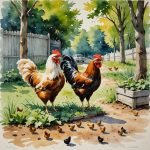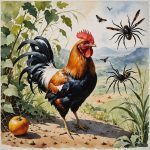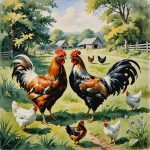In the bustling world of farm animals, one might think that chickens are constantly on the move, pecking and clucking their way through the day. Though, there is a peculiar behavior that sets these feathered creatures apart from the rest – a fascinating ability to keep their heads remarkably still. In this article, we will delve into the curious phenomenon of chickens maintaining a steady gaze, shedding light on this intriguing trait that is both mesmerizing and perplexing. Let us explore the mystery behind why chickens choose to keep their heads still, and what this behavior signifies in the intricate world of poultry.
Table of Contents
The biology behind chickens keeping their head still
Chickens have a unique ability to keep their head still while moving their bodies. This ability is due to a specialized structure in their neck called the cervical hinge. This hinge allows chickens to move their bodies while keeping their head stable and focused on a specific target. The cervical hinge also helps chickens maintain balance and stability, especially while foraging for food or evading predators.
When a chicken moves its body, the cervical hinge allows for swift and precise movements without disrupting the head’s position. This is crucial for chickens to navigate their surroundings and interact with other chickens. The ability to keep their head still while in motion showcases the unbelievable agility and control that chickens possess. Next time you observe a chicken roaming around, pay attention to how their head remains steady despite their body’s movements – it’s truly a fascinating display of biology in action!
Advantages of chickens head stabilization
With chickens, the ability to keep their head still provides numerous advantages that contribute to their overall well-being and productivity. one key benefit is improved vision, as a stable head allows chickens to focus on their surroundings more effectively. This heightened visual awareness helps them navigate their environment, locate food sources, and stay alert to potential threats.
Additionally, chickens with stabilized heads exhibit better balance and coordination, enabling them to move more gracefully and efficiently. This enhanced agility not only enhances their quality of life but also translates to increased productivity in terms of foraging, egg laying, and overall performance. the simple act of keeping their head still plays a crucial role in the daily life of chickens, impacting everything from their physical health to their behavioral patterns.
| Improved vision |
| Better balance |
| Enhanced agility |
Tips for observing chickens behavior
When observing chickens, you may notice that they have a fascinating behavior of keeping their head still while moving their bodies. This can be seen when they are walking around the yard or pecking at the ground for food. Their ability to lock their head in place allows them to focus on their surroundings and potential threats while still being able to move freely.
This behavior is a natural defense mechanism that chickens have developed over time to stay alert and aware of their environment. By keeping their head still, they are able to scan for predators or other dangers without drawing attention to themselves. Next time you watch your flock, pay close attention to how they move and interact with one another while keeping their head fixed in one position.
Practical applications of studying chickens head movement
Understanding how chickens keep their head still can have a wide range of practical applications, from robotics to virtual reality technology. By studying the intricate movements of a chicken’s head, researchers can gain valuable insights into how to design more stable and efficient systems.
One practical application of studying chickens’ head movement is in the field of robotics. By mimicking the way chickens keep their head stable while moving, engineers can develop robots that are more agile and precise. This can be particularly useful in applications such as search and rescue missions or industrial automation.
Q&A
Q: Why do chickens keep their head still when their body moves?
A: Chickens have a specialized system of stabilizing their vision called the vestibulo-ocular reflex, which allows them to keep their head steady while their body is in motion.
Q: How do chickens benefit from keeping their head still?
A: By keeping their head stationary, chickens can maintain a fixed point of reference in their environment, allowing them to better detect potential threats or sources of food.
Q: Can other animals exhibit a similar head-stabilizing behavior?
A: Yes, other birds and certain mammals also possess mechanisms for stabilizing their vision, particularly those that rely on precise visual acuity for hunting or navigating their surroundings.
Q: How does the vestibulo-ocular reflex in chickens compare to that of humans?
A: While humans also possess a vestibulo-ocular reflex, it is not as pronounced or efficient as in chickens.Chickens have evolved to have a highly specialized visual system to aid in their survival and foraging habits.
closing Remarks
the fascinating ability of chickens to keep their heads still while their bodies move provides a perfect example of the remarkable adaptations found in the animal kingdom. So next time you observe a chicken strutting around, take a moment to appreciate the intricate balance and coordination at work within these seemingly simple creatures.Let’s continue marveling at the wonders of the natural world, one chicken head at a time.
Meet Walter, the feathered-friend fanatic of Florida! Nestled in the sunshine state, Walter struts through life with his feathered companions, clucking his way to happiness. With a coop that’s fancier than a five-star hotel, he’s the Don Juan of the chicken world. When he’s not teaching his hens to do the cha-cha, you’ll find him in a heated debate with his prized rooster, Sir Clucks-a-Lot. Walter’s poultry passion is no yolk; he’s the sunny-side-up guy you never knew you needed in your flock of friends!






